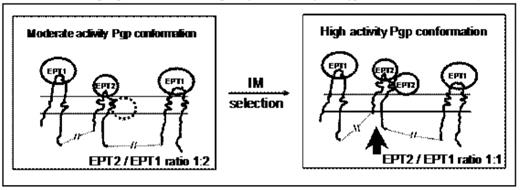Abstract
CML is considered as a model of multi step-developing malignancies. Although very effective in chronic phase CML, imatinib mesylate (IM) and second generation TK inhibitors treatment are usually less effective in advanced CML (accelerated and blast crisis phases) since drug-resistant clones inevitably shortly emerge. In a recent study (Simanovsky M et al, Differentiation. 2008 Apr 29 [Epub ahead of print]), we have demonstrated that at blast crisis CML (CML-BC), blood circulating blasts of the same CML clone are heterogeneous, containing a small cell-fraction (1–3%) of blasts that are significantly more aggressive than the major malignant population. Briefly, we found that these minor subsets (MS) of blasts (both from patients and human CML-BC cell lines) have a typical highly repopulating ability, increased clonogenicity, and over expression of BCR-ABL and few other cancer-related genes. To evaluate whether the MS blasts also exhibit differential drug resistance mechanisms toward IM, we compared the two blast subsets for the level of resistance to IM in relation to expression of a functional Pgp, an ABC transporter that is the product of the ABCB1 (MDR1) gene. In the current study, we found that the MDR1 gene (but not several other ABC transporter genes) is significantly (5–7 fold) upregulated in the MS blasts, relatively to the major population. Moreover, FACS and Western analyses revealed that while Pgp could not be detected on the cell surface of the major blast subsets, Pgp is exclusively highly expressed in the MS blasts. Moreover, functional Pgp assays in the MS blasts (efflux, dose-dependent competitions, and UIC2 Pgp-specific shift assays) indicated unequivocally that IM is a substrate for Pgp. While IM efficiently inhibited the proliferation of the major blasts in dose-dependent manner, the proliferation rate of the MS blasts was essentially not affected. Furthermore, the anti-proliferative effect of IM on the MS blasts could be restored by addition of the Pgp inhibitor, R-verapamil, in dose-dependent manner. While relatively long, gradual selection in culture of the major CML-BC subsets resulted in some Pgp-independent IM-resistant clones, Pgp activity levels were shortly further elevated (by 1-order magnitude) in the MS blasts. Interestingly, FACS analyses, using different monoclonal antibodies that bind specifically to different known extra cellular epitopes of Pgp, indicated differential antibodies-epitopes binding ratios after IM selection. These stoichiometric changes suggest a topological folding shift of Pgp between its moderate to high activity (proposed model, Figure 1). In conclusion, the existence of a minor “pool” of CML blasts of both greater clonogenicity and high expression and activity levels of Pgp, apparently signify clonal evolution toward both increased malignancy and lower therapeutic sensitivity. Moreover, as both IM and Dasatinb are transported by Pgp, this study suggests that their combination therapy with Pgp-modulateors might also be clinically effective in targeting this aggressive blast population.
The proposed model of topological folding of Pgp in relation to activity.
Disclosures: No relevant conflicts of interest to declare.
Author notes
Corresponding author


This feature is available to Subscribers Only
Sign In or Create an Account Close Modal